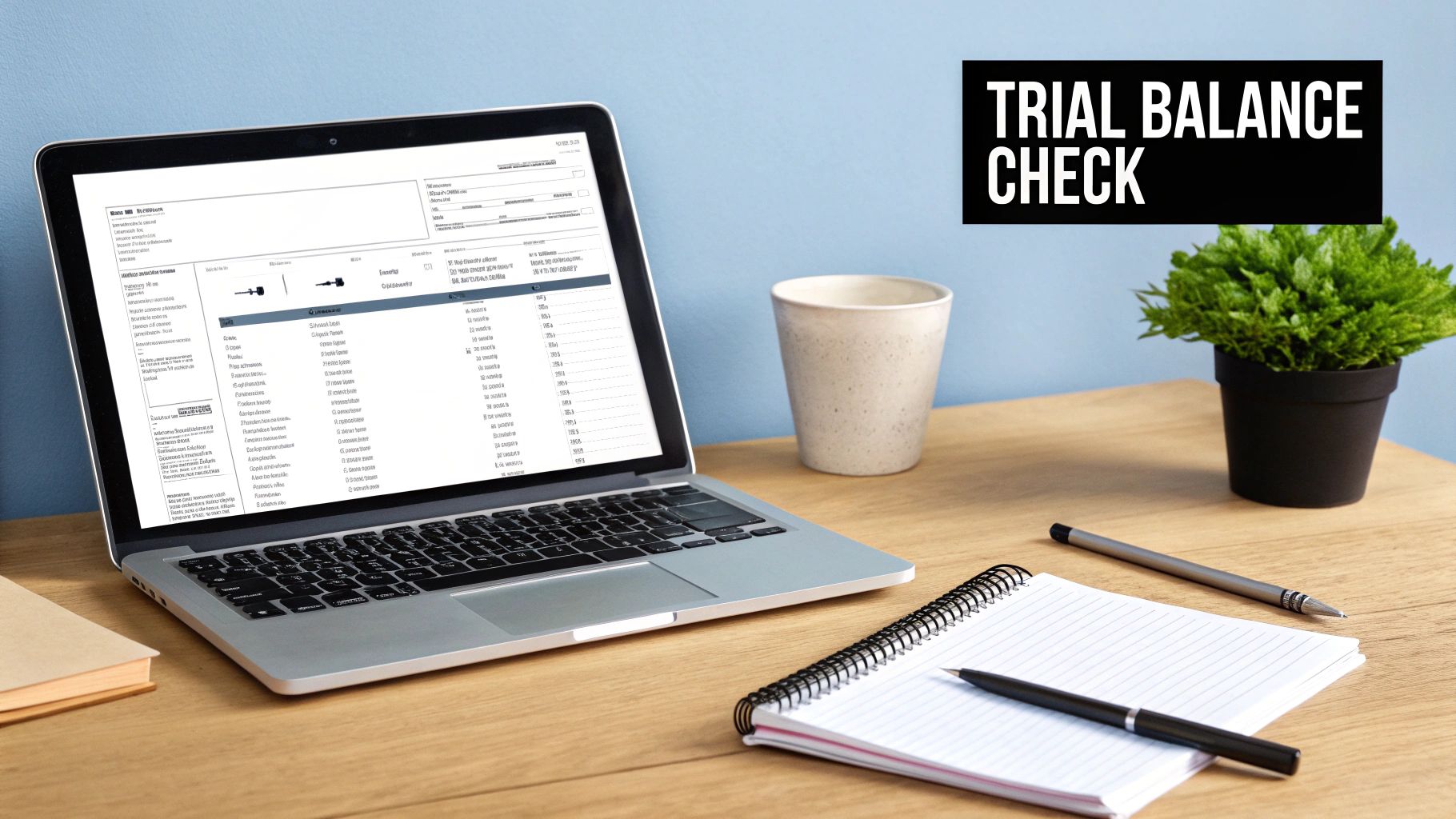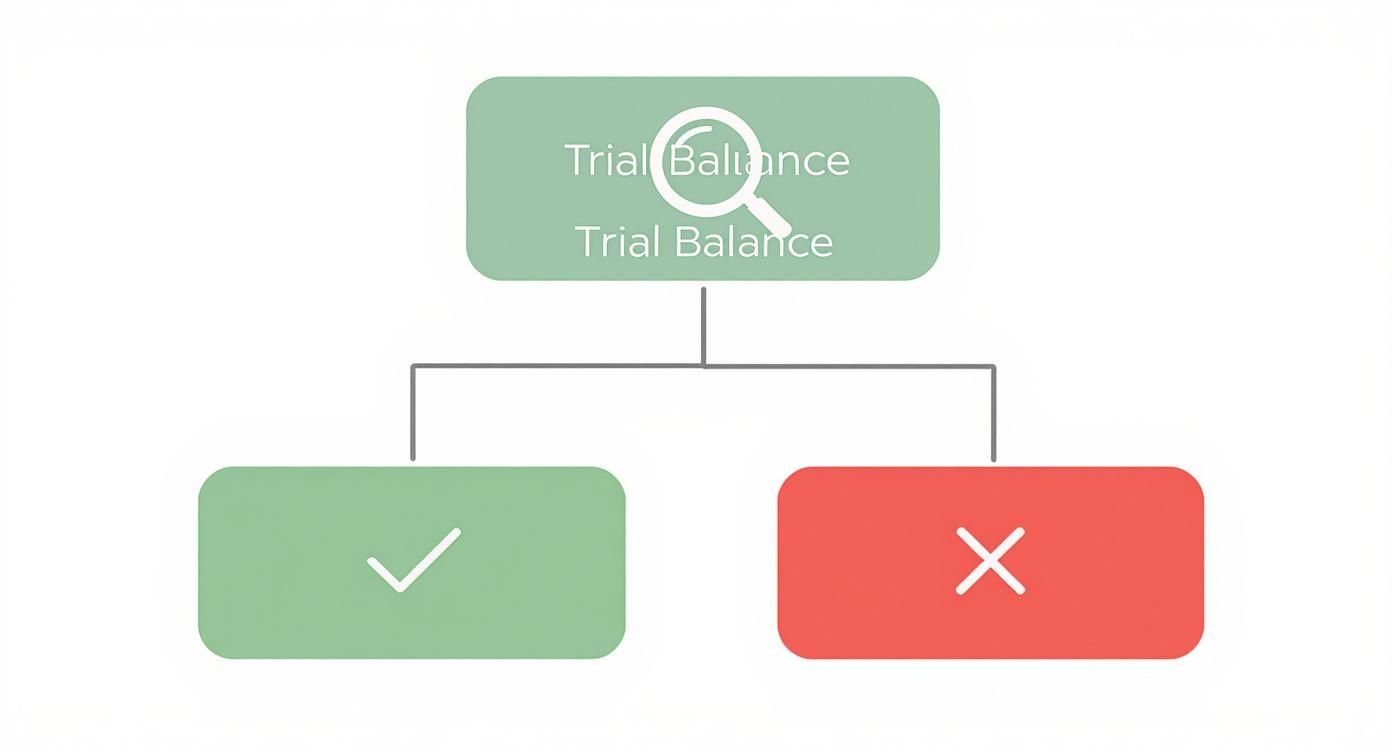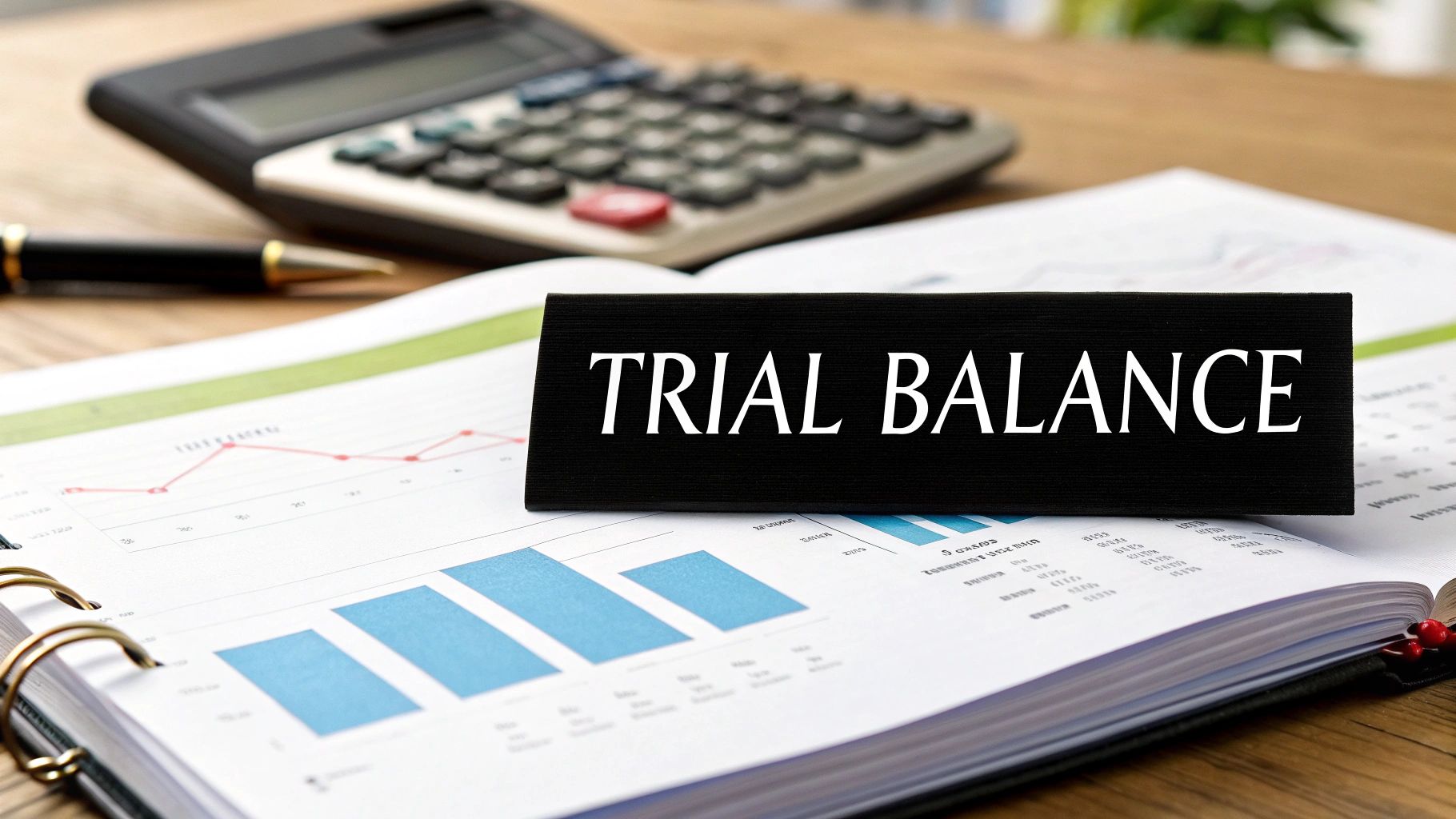At its heart, a trial balance is an internal gut-check for your company's bookkeeping. Think of it as a crucial step to make sure everything adds up correctly before you go any further. It pulls every account from your general ledger into one report with a simple, yet critical, goal: to confirm that total debits equal total credits. This single check is the bedrock of double-entry accounting and your first real step toward creating financial statements you can trust.
Understanding The Primary Role Of A Trial Balance

Imagine a trial balance as the quality control checkpoint on an assembly line. Before you can build your official financial reports—like the income statement or balance sheet—you need to know for certain that the underlying numbers are solid. The trial balance does exactly that, giving you a neatly summarized view of every account balance in one place.
This isn't a new concept. The trial balance has been a fundamental tool since the double-entry system was first written down in the 15th century. It's always served as the go-to checkpoint for making sure debits and credits are perfectly in sync.
Its most important job is to flag mathematical mistakes early on. If the debit and credit columns don't match, that’s an immediate red flag telling you an error is hiding somewhere in the general ledger. This simple validation stops small inaccuracies from snowballing into major problems in your financial statements, which could lead to misguided business decisions.
Primary Uses Of A Trial Balance at a Glance
A trial balance is far more than a simple list of numbers; it's a diagnostic tool that underpins the entire accounting cycle. The table below breaks down its key roles.
| Function | Description | Impact on Business |
|---|---|---|
| Error Detection | Serves as the first line of defense to find mathematical errors in journal entries. | Prevents mistakes from corrupting financial statements and saves time on troubleshooting. |
| Financial Reporting | Provides the organized, balanced numbers needed to create the income statement and balance sheet. | Ensures the final reports are built on a foundation of accurate, verified data. |
| Audit Preparation | Organizes ledger accounts and proves the books are balanced before an internal or external audit. | Makes the audit process smoother and demonstrates strong internal financial controls. |
As you can see, each function is vital for maintaining financial integrity. For businesses looking to ensure precision, using efficient outsourced accounting services can be a smart move to manage the processes that result in an accurate trial balance.
By getting a handle on this report, you can significantly boost the reliability of your financial records. When you're ready to put this knowledge into practice, our step-by-step guide on how to prepare a trial balance is a great place to start.
Detecting Errors Before They Become Problems
Think of the trial balance as your first line of defense in the bookkeeping process. It’s an essential diagnostic tool—an early warning system that tells you if something’s mathematically off in your books.
When your debits and credits line up perfectly, that's a great first sign. But its real value shines when they don't. An unbalanced trial balance is an undeniable red flag that a mistake has been made somewhere in the general ledger, forcing you to investigate before a small error snowballs into a major reporting headache.
Common Errors a Trial Balance Can Catch
The trial balance is brilliant at catching some of the most common, and frankly, most human, mistakes made during data entry. We've all been there. It's great at flagging things like:
- Transposition Errors: This is a classic. It’s when you accidentally flip two numbers, like recording a $97 payment when it was actually $79. The numbers are the same, but the order is wrong, and the trial balance will catch it.
- Posting to the Wrong Column: Another frequent slip-up is putting a debit amount in the credit column (or the other way around). This immediately throws the whole report out of whack.
- Calculation Mistakes: Simple math errors, like a slip of the finger on a calculator when totaling an account balance, will be exposed when the final debit and credit columns don't agree.
A trial balance is your accounting safety net. It won't catch every single type of error, but it's incredibly effective at stopping basic mathematical mistakes from corrupting your financial statements.
It's just as important, however, to understand what a trial balance can't do. For example, if a transaction was never recorded at all, the trial balance wouldn't know. It would still balance. The same goes for posting an amount to the wrong account—say, debiting Office Supplies instead of Equipment. The math is right, so the trial balance will still look perfect.
This is why getting a balanced report is just one piece of the puzzle. It confirms the numbers add up, but it must be followed by a proper review and reconciliation. For more on that critical next step, take a look at our guide on what is general ledger reconciliation. Using these tools together is how you build a solid, reliable system for keeping your financial records straight.
Building the Foundation for Financial Statements
Think of a trial balance as less of an internal checklist and more of a critical bridge. It’s what connects the dots between your day-to-day bookkeeping and the high-stakes financial reports you share with the world. Essentially, it's the financial blueprint for your company's story.
Once you’ve made all the necessary adjustments, the adjusted trial balance provides the final, verified numbers you need to move forward. It’s the single source of truth that ensures every figure on your statements is both accurate and, just as importantly, balanced. Trying to prepare financial statements without it would be like building a house without a foundation—a recipe for disaster.
This infographic breaks down what a trial balance can and can't catch.

As you can see, it’s a powerhouse for spotting math errors, but it won't flag an entire transaction that was never recorded. That's why a human review is always part of the process.
From Trial Balance to Official Reports
So, how does this raw data become a polished financial statement? The process is actually pretty methodical. Accountants simply pull the finalized numbers from the adjusted trial balance and slot them into their designated reports.
- For the Income Statement: We grab all the revenue and expense accounts. These numbers are used to calculate whether the company turned a profit or a loss over that period.
- For the Balance Sheet: We take all the asset, liability, and equity accounts. This gives us a clear snapshot of the company’s financial health on a specific date.
A clean, adjusted trial balance is the final green light in the accounting cycle. It confirms that your books are arithmetically sound and ready for the creation of official financial reports that stakeholders, lenders, and investors rely on.
This systematic process is what transforms raw ledger data into something truly meaningful. For a closer look at this in action, some resources do a great job of explaining how trial balances contribute to robust financial statements.
Ultimately, seeing how these reports connect is the key. You can get a better handle on the final product by checking out our guide on what are the financial statements and what they're used for.
Using Trial Balances for Inventory Control
So, what's a trial balance really for, beyond just making sure the debits and credits line up? When you get into the nitty-gritty of running a business with physical products, it becomes an indispensable tool for keeping your inventory in check. Think of it as the bridge between what your accounting books say you have and what’s actually sitting on your warehouse shelves.
For many companies, inventory is one of their biggest assets. If the value in your general ledger doesn't match the reality of your stock, it can throw off your entire financial picture, distorting your company's health. A discrepancy is a red flag, pointing to potential problems like theft, unreported damage, or just simple clerical mistakes that need to be fixed—fast.
Ensuring Physical Stock Matches Financial Records
To get this right, accountants don't just use a standard trial balance; they use specialized reports that act like a fine-toothed comb for inventory. This is one of the most practical and powerful uses of a trial balance in a modern business.
A great example is the Historical Inventory Trial Balance (HITB) report, a feature in accounting systems like Microsoft Dynamics GP. This report is built for one specific purpose: to confirm that the detailed inventory records (the sub-ledger) perfectly match the inventory control account in the general ledger. You can learn more about how companies achieve a true inventory balance with specialized reports.
This detailed reconciliation allows accountants to make precise adjustments for real-world inventory changes, including:
- Damaged Goods: Writing off items that are broken, spoiled, or can't be sold.
- Obsolete Stock: Removing old products that have no market value from the asset list.
- In-Service Items: Reclassifying stock that was pulled for internal use, like for product demos.
By comparing the inventory sub-ledger to the general ledger control account, a business can confirm its inventory valuation is accurate down to the last dollar. This is a tangible example of the trial balance acting as a vital tool for both financial and operational control.
In the end, this proves the trial balance is much more than a simple error-checking tool. It’s a workhorse report that helps maintain the financial integrity of a company's most important physical assets, ensuring the numbers on the screen accurately reflect the reality on the ground.
Improving Cash Flow and Managing Receivables

A trial balance does more than just spot math errors. When you know how to use it, it becomes a powerful strategic tool that can seriously boost your company's financial health. It's no longer just a static report; it's a dynamic instrument for shoring up your cash position, especially when it comes to who owes you money.
This is where a specific version, the Aged Receivables Trial Balance, really shines. Think of it as a detailed breakdown of all your customer invoices, sorted by how long they've been sitting unpaid. It gives managers a crystal-clear, at-a-glance view of who owes what and, crucially, for how long.
Gaining Control Over Outstanding Payments
The Aged Receivables Trial Balance takes your accounts receivable and neatly sorts every unpaid invoice into time-based categories. It's a foundational practice for solid financial management.
For instance, a standard report will typically bucket your receivables like this:
- Current: Invoices that are still within their payment terms.
- 1-30 Days Overdue: These are the first red flags—recently missed payments that need a gentle nudge.
- 31-60 Days Overdue: Now things are getting more serious. These invoices require focused collection efforts.
- 61+ Days Overdue: These are high-risk debts. It might be time for more assertive action.
By keeping a close eye on this report, your finance team can catch collection problems before they spiral. If you want to dig deeper into this, check out our guide on what is accounts receivable management. This kind of proactive monitoring helps a business predict its incoming cash with far greater accuracy.
This specialized trial balance turns a simple list of numbers into a strategic roadmap for boosting cash flow. It tells you when to follow up, when to pump the brakes on extending more credit, and how to prepare for potential cash shortfalls.
Ultimately, this report is all about managing credit risk. Tools like the Receivables Historical Aged Trial Balance report in Microsoft Dynamics GP even let companies look back at outstanding balances on any given past date. Businesses that make a habit of reviewing aged trial balances can slash their accounts receivable days outstanding by up to 15-20%—a direct injection of cash into the company. This really drives home how vital the trial balance is for keeping your business on a healthy, stable financial footing.
Answering Your Top Trial Balance Questions
Even after you get the hang of what a trial balance does, a few practical questions always seem to pop up. Let's tackle the most common ones head-on.
Think of this as a quick FAQ to clear up any lingering confusion and make sure you're ready to put this knowledge to work on your own books.
Is a Trial Balance the Same as a Balance Sheet?
Not at all, though it's a common point of confusion. They serve completely different roles.
Think of the trial balance as an internal tool—a behind-the-scenes check to make sure your debits and credits are in sync. It’s your first line of defense against mathematical errors before you create anything official.
The balance sheet, on the other hand, is a formal financial statement. This is the polished report you share with investors, lenders, and other outsiders. It shows a snapshot of your company's financial health (assets, liabilities, and equity) on a specific date. The trial balance helps you build the balance sheet, but they are not the same thing.
How Often Should You Prepare a Trial Balance?
For most businesses, running a trial balance at the end of each accounting period—usually monthly—is standard practice. This routine helps you catch errors early, keeping your books clean and preventing small mistakes from snowballing into major headaches.
That said, you can run one anytime you need a quick gut check on your general ledger accounts.
What Are the Different Types of Trial Balances?
You'll encounter three main types of trial balances, each corresponding to a different step in the accounting cycle.
- Unadjusted Trial Balance: This is the first one you'll prepare. It's pulled together right after all the day-to-day transactions are logged but before any end-of-period adjustments are made. Think of it as a rough draft to spot any basic posting mistakes.
- Adjusted Trial Balance: Once you’ve made your adjusting entries (like accounting for depreciation or accrued expenses), you'll run this version. It gives a much more accurate view of your financial standing and is the direct source for building your income statement and balance sheet.
- Post-Closing Trial Balance: This is the final step. After closing out all your temporary accounts (like revenue and expenses) for the period, this report is generated. It only lists permanent accounts (assets, liabilities, and equity), confirming your books are balanced and all set for the next accounting period.
The goal is always the same for all three: make sure debits equal credits. The real difference is simply when you prepare it and what information it includes, marking your progress through the accounting cycle.
Getting these distinctions down is key to understanding how this simple report is a cornerstone of the entire financial reporting process.
At Bank Statement Convert PDF, we provide powerful software that simplifies the process of converting your bank statement PDFs into organized Excel spreadsheets. Our tool is designed for accountants, entrepreneurs, and business owners who demand accuracy and efficiency in their financial workflows. Learn more about how we can streamline your bookkeeping today!


